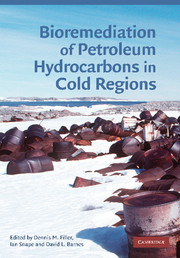Book contents
- Frontmatter
- Contents
- List of contributors
- Preface
- Glossary
- 1 Contamination, regulation, and remediation: an introduction to bioremediation of petroleum hydrocarbons in cold regions
- 2 Freezing and frozen soils
- 3 Movement of petroleum through freezing and frozen soils
- 4 Hydrocarbon-degrading bacteria in contaminated cold soils
- 5 Temperature effects on biodegradation of petroleum contaminants in cold soils
- 6 Analytical methods for petroleum in cold region soils
- 7 Treatability studies: microcosms, mesocosms, and field trials
- 8 Nutrient requirements for bioremediation
- 9 Landfarming
- 10 Thermally enhanced bioremediation and integrated systems
- 11 Emerging technologies
- References
- Index
2 - Freezing and frozen soils
Published online by Cambridge University Press: 22 August 2009
- Frontmatter
- Contents
- List of contributors
- Preface
- Glossary
- 1 Contamination, regulation, and remediation: an introduction to bioremediation of petroleum hydrocarbons in cold regions
- 2 Freezing and frozen soils
- 3 Movement of petroleum through freezing and frozen soils
- 4 Hydrocarbon-degrading bacteria in contaminated cold soils
- 5 Temperature effects on biodegradation of petroleum contaminants in cold soils
- 6 Analytical methods for petroleum in cold region soils
- 7 Treatability studies: microcosms, mesocosms, and field trials
- 8 Nutrient requirements for bioremediation
- 9 Landfarming
- 10 Thermally enhanced bioremediation and integrated systems
- 11 Emerging technologies
- References
- Index
Summary
Introduction
Frozen soil is defined as a soil where the soil moisture has turned totally or partially into ice. On the other hand, permafrost is defined solely on the basis of soil temperature. If the soil temperature remains below 0 °C for at least two years, the soil is considered permafrost. The upper layer of the permafrost undergoes a cyclic temperature change during the year from frozen in the winter to thawed in the summer. This layer is called the active layer or seasonally thawed layer. The active layer in a permafrost region can extend from as little as 20 cm to about 2 m (Shur et al. 2005) depending on climate, soil texture, and organic content above mineral soil. In areas without permafrost the layer of soil which is frozen in the winter is called the seasonally frozen layer. Most permafrost on earth is thousands of years old, but some can be quite new. In permafrost regions, contaminant impacts generally initiate at or near the soil surface and affect the active layer, suprapermafrost water, and uppermost permafrost (Chapter 3). It is this realm that most concerns environmental scientists and engineers tasked with environmental cleanup. A thorough understanding of properties of the active layer and the upper permafrost is necessary for planning and implementing effective remediation of cold media.
Review and recent advances
Thermal and physical properties of frozen ground
Thermal conductivity of soils
The thermal conductivity of soil is the measure of its ability to conduct heat. Soil thermal conductivity is a function of the thermal state of the ground (frozen or unfrozen), water content, dry density, gradation, and mineralogy.
- Type
- Chapter
- Information
- Bioremediation of Petroleum Hydrocarbons in Cold Regions , pp. 38 - 54Publisher: Cambridge University PressPrint publication year: 2008
- 1
- Cited by

